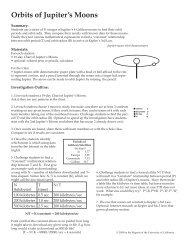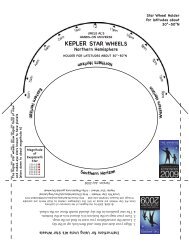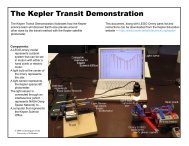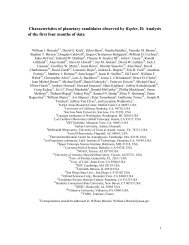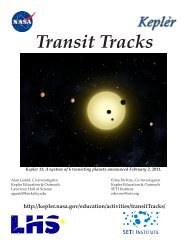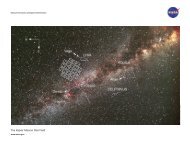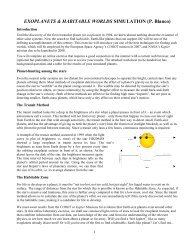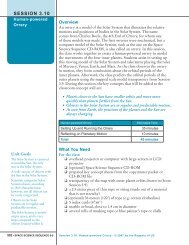Poster Abstracts - Kepler - NASA
Poster Abstracts - Kepler - NASA
Poster Abstracts - Kepler - NASA
- No tags were found...
You also want an ePaper? Increase the reach of your titles
YUMPU automatically turns print PDFs into web optimized ePapers that Google loves.
POSTER ABSTRACTSP0711. POSTER SESSION IISTELLAR DIFFERENTIAL ROTATION ESTIMATES FROM PLANETARY TRANSITS Adriana Valio 11Center for Radio Astronomy and Astrophysics Mackenzie, Mackenzie University, Rua da Consolacao, 896, SaoPaulo, Brazil, avalio@craam.mackenzie.brAbout 25% of the extra solar planets discovered sofar transit their host star. During the eclipse of star byits orbiting planet, spots on the surface of the star maybe occulted, causing small variation in the transit lightcurve.These variations can be modeled using themethod described in [1] that yields the starspots physicalproperties such as size, position, and temperature(or intensity). Presently, the transit light curves of HD209458 [1], CoRoT-2 [2,3,4], CoRoT-4 [5], CoRoT-5,CoRoT-6 [5], CoRoT-8, CoRoT-11, CoRoT-12, andCoRoT-17 have been analyzed, and their spots characteristicsdetermined.Just like Galileo did four centuries ago for the Sun,from the spot analysis it is also possible to calculatethe stellar rotation period and whether it presents ornot differential rotation. The mean rotation period ofthe star is obtained from the out-of-transit light curve,whereas the differential rotation is estimated from thesuccessive transits of the supposedly same spot. Hencewe obtain the value of the rotation period at thelatitude of the transit. Moreover, using the knownvalue of the average rotation period (the out-of-transitrotation period), it is possible to determine the profileof stellar rotation as a function of latitude. So far, Ihave considered a profile similar to that of the Sun:360 oP α =A−B sin 2 (1)αwhere α is the latitude, A and B are constants to bedetermined for each star. The relative differentialrotation is defined as: = P −P pole eq(2)Pwhere P is the average rotation period. Theestimated relative diferential rotation of the starsstudied thus far varies from 3 to 50%.For systems with multiple planets such as those that<strong>Kepler</strong> has discovered [6,7], that transit their host staron different projected stellar latitudes, it is possible toconfirm if the differential rotation profiles are similaror not to the solar profile given by Eq.(1).[4] Lanza, A. F., Bonomo, A. S., Pagano, I. et al.2011, A&A, 525, 14[5] Valio, A. & Lanza, A. F. 2011, ApJ (submitted)[6] Lissauer, J. J., Fabrycky, d. C., Ford, E. B. 2011,Nature, 470, 53[7] Borucki, W. J., Koch, D. G., Basri, G. 2011, ApJ,736, 19References:[1] Silva, A. V. R. 2003, ApJL, 585, 147[2] Silva-Valio, A., Lanza, A. F.; Alonso, R.; Barge, P.2010, A&A, 510, 25[3] Silva-Valio, A. & Lanza, A. F. 2011, A&A 529, 361942011 <strong>Kepler</strong> Science Conference - <strong>NASA</strong> Ames Research Center



